Catch Comet NEOWISE while you still can. Comet NEOWISE was as bright as hoped when it swung out from its July 3rd perihelion into the low morning sky. It's dimly visible to the naked eye, though binoculars do better, and fairly small. Chris Schur of Payson, Arizona, wrote on July 5th, "The comet continues to be stunning, rising tail-first over the plateau some 20 miles distant. I was able to easily see it naked eye with about a degree of tail visually. Gorgeous yellow color in the scope."
As of Saturday morning July 11th it should be about magnitude 2 or 3, but atmospheric extinction at its low altitude, and its involvement with morning twilight, reduce its visibility compared to what that magnitude might suggest. It's fading day by day, so don't wait!
Scan for it with binoculars very low in the northeast, lower left of Capella, as dawn is beginning: starting roughly 1 hour 45 minutes before your local sunrise time. (This applies to the world's mid-northern latitudes.)
Then around July 14th, the comet's best visibility will switch from dawn to dusk, low in the north-northwest around the end of twilight. Look far below the Big Dipper, which is hanging by its handle high in the northwest, and a little to the right. By then it's likely to be magnitude 3 or 4. From then on it will gain altitude late in evening twilight as it fades further.
See Bob King's Comet NEOWISE Delights at Dawn, with a chart of the comet's path across easternmost Auriga, Lynx, and the feet of Ursa Major.
Two supernovae for amateur telescopes have recently erupted in the western evening sky, both 12th magnitude and both in the Virgo Galaxy Cluster: in M85 and NGC 4457. See Bob King's Two Bright Supernovae Light Up Nearby Galaxies with finder charts and photos.
FRIDAY, JULY 10
■ Jupiter and Saturn rise in twilight this week. Mars is a fire-beacon high in the southeast in early dawn, and the Moon joins it there tomorrow and Sunday mornings July 11th and 12th. On those same two mornings, Venus passes just 1° from Aldebaran. Here are the scenes for some of those planets:
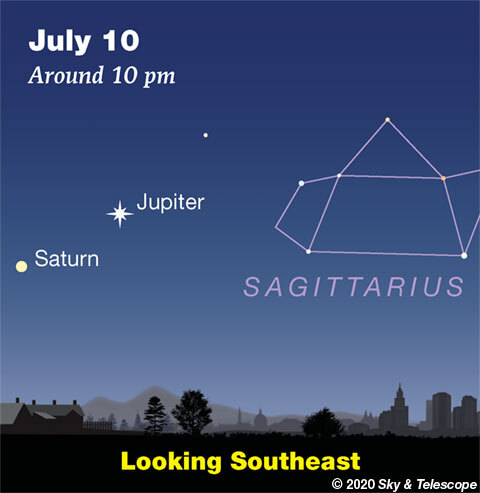
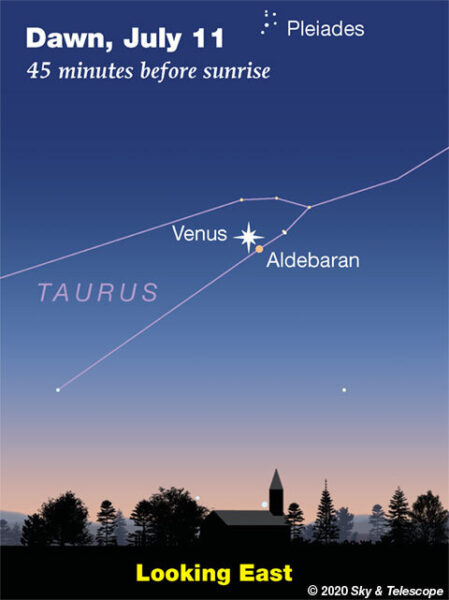
SATURDAY, JULY 11
■ If you have a dark enough sky, the Milky Way now forms a magnificent arch high across the whole eastern sky after nightfall is complete. It runs all the way from below Cassiopeia in the north-northeast, up and across Cygnus and the Summer Triangle in the east, and down past the spout of the Sagittarius Teapot in the south-southeast.
Meanwhile the Big Dipper, high in the northwest after dark, is dipping down to "scoop water" through the evenings of summer and early fall.
■ Take a look low in the east after about 1 a.m. and there will be the waning Moon, nearly last quarter, with brilliant Mars roughly 5° to its upper right (for North America). By dawn Sunday morning, they shine high in the southeast.
SUNDAY, JULY 12
■ After nightfall, spot Altair in the east-southeast. It's the second-brightest star on the whole eastern side of the sky, after Vega high to its upper left.
Above Altair by a finger-width at arm's length is little orange Tarazed. A bit more than a fist to Altair's left or lower left is little Delphinus, the Dolphin, leaping leftward.
■ Last-quarter Moon (exactly so at 7:29 p.m. EDT). The Moon clears the horizon due east around 1 a.m. tonight, with Mars now shining some 16° to its upper right.
MONDAY, JULY 13
■ Starry Scorpius is sometimes called "the Orion of Summer" — for its brightness, its blue-white giant stars, and its prominent red supergiant (Antares in the case of Scorpius, Betelgeuse for Orion). But Scorpius passes a lot lower across the southern sky than Orion does, for those of us at mid-northern latitudes. That means it has only one really good evening month: July.
Catch Scorpius due south soon after dark, before it starts to tilt lower toward the southwest. It's full of deep-sky objects to hunt out with good charts using a telescope or even binoculars. Of course, you'll need to know how to use sky charts with a telescope.
TUESDAY, JULY 14
■ Jupiter is at opposition tonight, opposite the Sun as seen from Earth. For all practical purposes, this is when Jupiter is its closest and brightest for the year. All this July and August Jupiter is the brightest point in the night, until Venus rises in the early morning hours.
■ Three doubles at the top of Scorpius. The head of Scorpius — the near-vertical row of three stars upper right of Antares — stands highest in the south right after dark. The top star of the row is Beta Scorpii or Graffias, a fine double star for telescopes.
Just 1° below it is the very wide naked-eye pair Omega1 and Omega2 Scorpii, not quite vertical. They're both 4th magnitude. Binoculars show their slight color difference; they're spectral types B9 and G2.
Left of Beta by 1.6° is Nu Scorpii, another fine telescopic double. Or rather triple. High power in good seeing reveals Nu's brighter component itself to be a close binary, separation 2 arcseconds and aligned almost north-south.
WEDNESDAY, JULY 15
■ At the end of these long summer twilights, check the sky low in the northwest and north. Would you recognize noctilucent clouds if you saw them? They're the most astronomical of all cloud types, being formed on meteor dust very high in the upper atmosphere. They're fairly rare, though they've been growing more common in recent decades as Earth's atmosphere changes. See Bob King's Nights of Noctilucent Clouds.
THURSDAY, JULY 16
■ One of the nice summer star clusters for binoculars is IC 4665 just over the eastern shoulder of Ophiuchus. It's large but sparse, with ten 7th- and 8th-magnitude stars spanning about a third of a degree. In a telescope they seem to me spell, raggedly, the greeting "HI" (when south-southwest is oriented up).
Why does an object this noticeable bear only an IC number? It was independently discovered and recorded at least four times between 1745 and 1908, when Solon Bailey at Harvard finally added it into the Index Catalogue being appended to the NGC. See Matt Wedel's Binocular Highlight story and chart in the July Sky & Telescope, page 43.
■ On Friday morning the 17th, the waning Moon groups up in a triangle with bright Venus and much fainter Aldebaran as shown below.
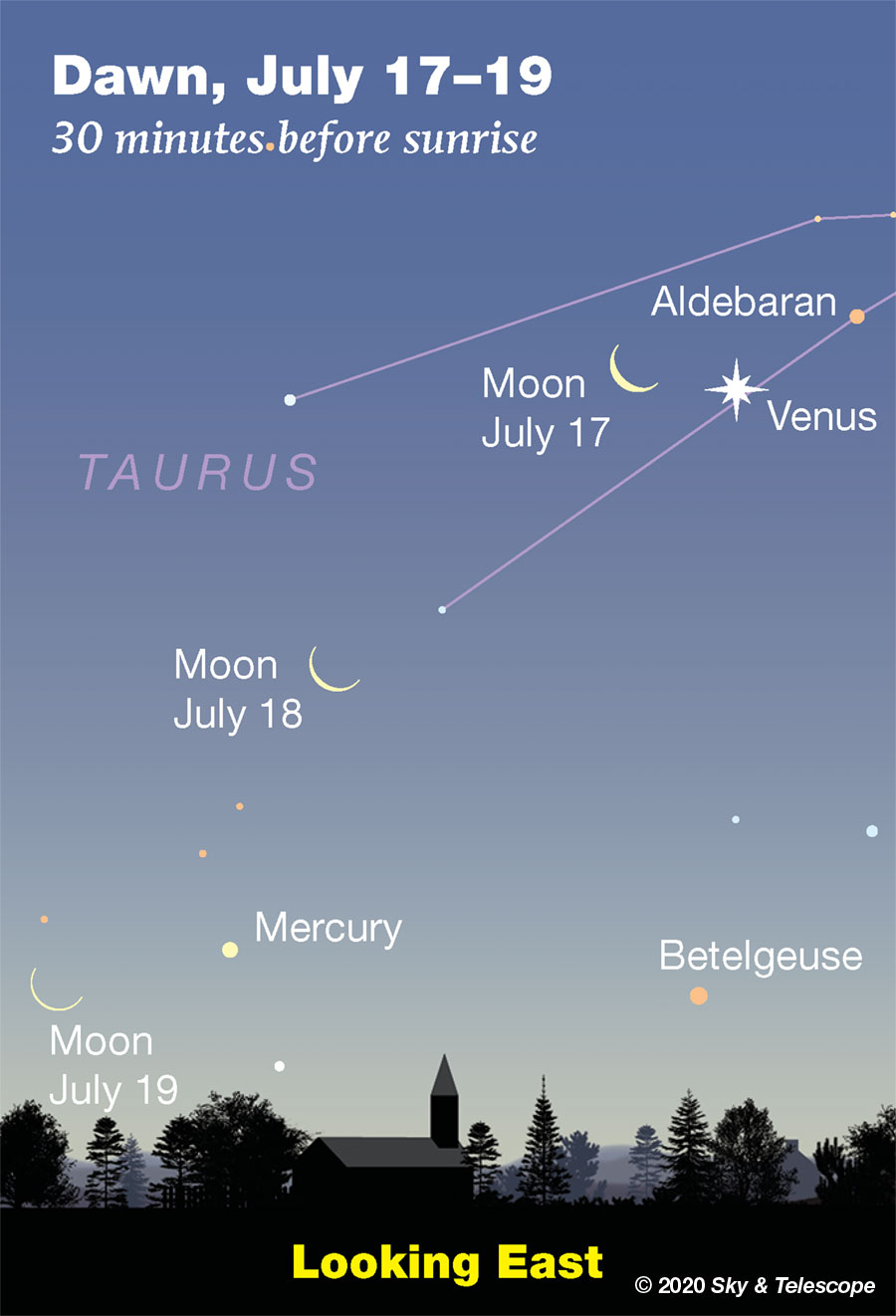
FRIDAY, JULY 17
■ As summer progresses, bright Arcturus is moving down the western side of the evening sky. Its pale ginger-ale tint always helps identify it.
Arcturus forms the bottom point of the Kite of Bootes. The Kite, rather narrow, extends upper right from Arcturus by 23°, about two fists at arm's length. The top of the kite is bent slightly down, as if something banged into it.
SATURDAY, JULY 18
■ The tail of Scorpius is low in the south after dark, lower right of the Sagittarius Teapot. How low depends on how far north or south you live: the farther south, the higher.
Look for the two stars especially close together in the tail. These are Lambda and fainter Upsilon Scorpii, known as the Cat's Eyes. They're canted at an angle; the cat is tilting his head and winking.
A line through the Cat's Eyes points west (right) by nearly a fist-width toward Mu Scorpii, a much tighter pair known as the Little Cat's Eyes. They're oriented almost exactly the same way as Lambda and Upsilon. Can you resolve the Mu pair without using binoculars? It takes sharp eyes!
This Week's Planet Roundup
Mercury becomes barely visible by the end of the week, very low in the dawn as shown above. Use the Moon and Venus to guide your way.
Venus (magnitude –4.7) now rises before the beginning of dawn and shines brightly in the east as dawn gets under way. Look for Aldebaran, much fainter at 1st magnitude, near it. They're only 1° apart on the mornings of July 11th and 12th, widening to 3½° by the 18th.
Before dawn grows bright, catch the Pleiades about 14° above Venus. Binoculars help. And use binoculars for the 3rd- and 4th-magnitude Hyades stars near Venus, as plotted below.
In a telescope Venus is still a large crescent, shrinking this week from 39 to 35 arcseconds tall and waxing from 24% to 33% sunlit.
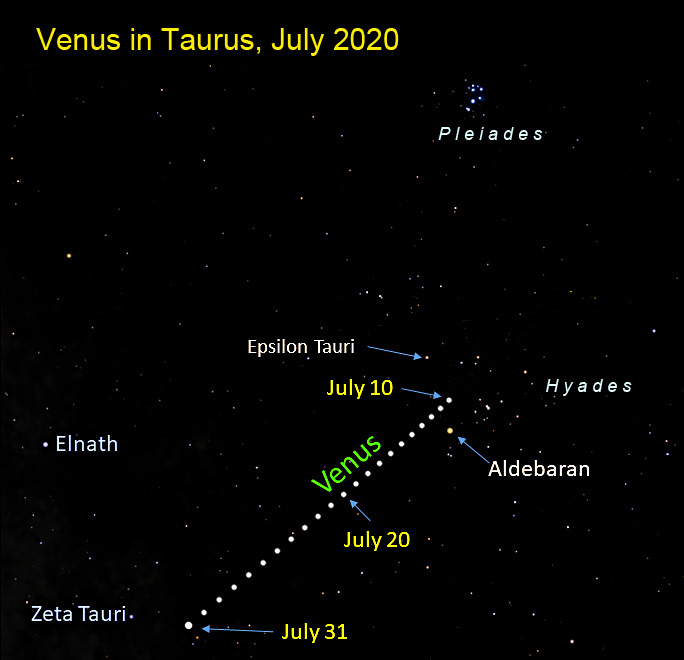
Mars rises due east around midnight daylight saving time, shining bright orange (magnitude –0.7) between Pisces and Cetus. Watch for it to come up below the Great Square of Pegasus. By the first light of dawn Mars shines grandly high and bright in the southeast like a distant bonfire in the sky.
In a telescope Mars grows from 12 to 13 arcseconds in apparent diameter this week; we're approaching it as Earth speeds along in our faster orbit around the Sun. Mars is still very gibbous, 85% sunlit. Look for its white South Polar cap and for subtler dark surface markings. For a map of the side of Mars facing you at your date and time, use our Mars Profiler. The map there is rectangular; remember to mentally wrap it onto the side of a globe.
Jupiter and Saturn (magnitudes –2.8, and +0.1, respectively) are coming to opposition: Jupiter on the night of July 13th, Saturn on the 20th. They rise around sunset, loom low in the southeast in twilight, and climb as the evening grows late. Jupiter is brightest; Saturn is 7° to its lower left. Farther to Jupiter's right, look for the Sagittarius Teapot. The two planets are highest around midnight.
Keep up with the telescopic interplay of Jupiter with its moons and their shadows, and find the transit times of Jupiter's Great Red Spot, in the July Sky & Telescope, page 50.
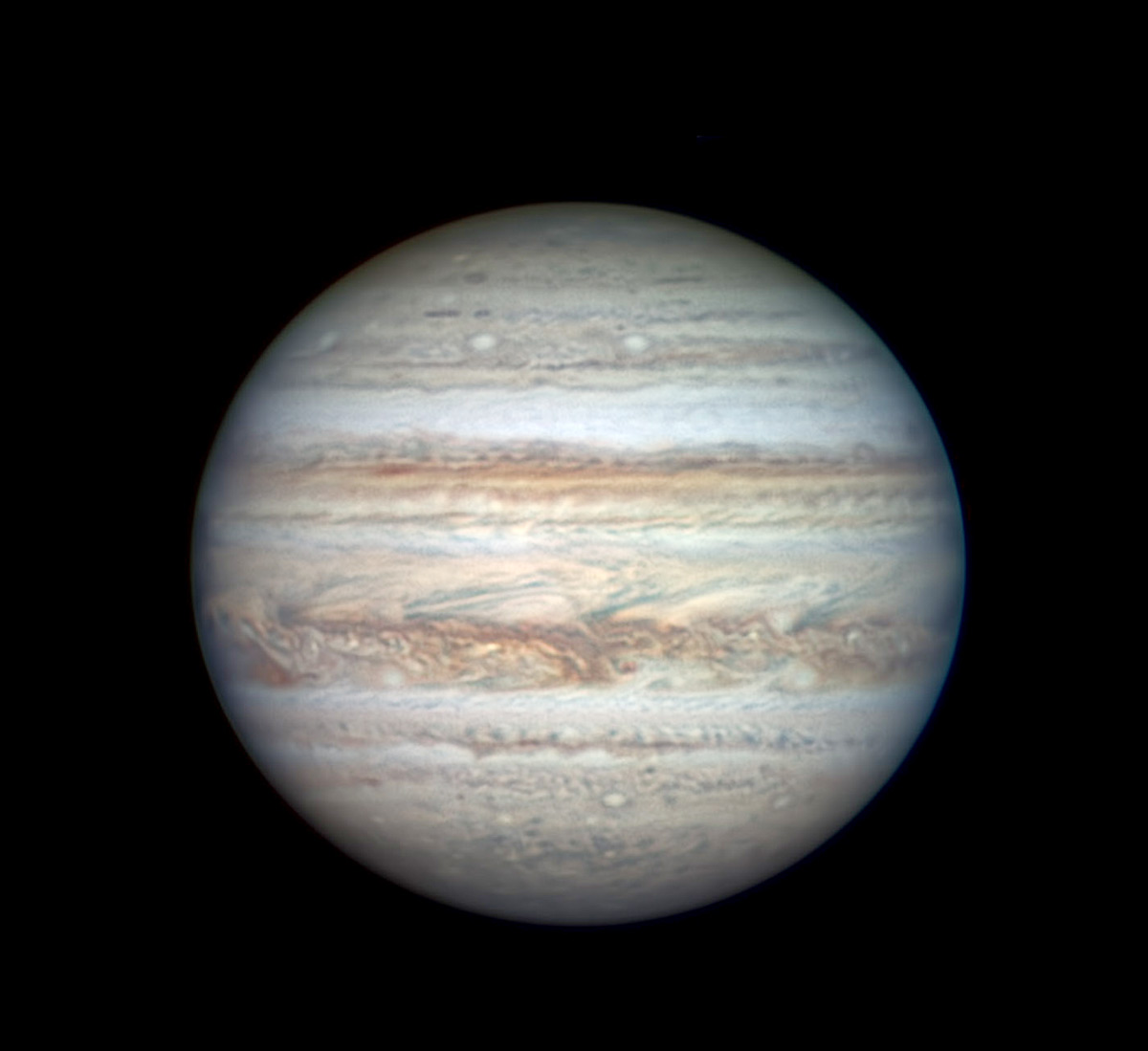
Uranus (magnitude 5.8, in Aries) is well up in the east just before dawn, about midway between Venus and Mars.
Neptune (magnitude 7.9, in Aquarius) is high in the south-southeast before dawn, west of Mars.
All descriptions that relate to your horizon — including the words up, down, right, and left — are written for the world's mid-northern latitudes. Descriptions that also depend on longitude (mainly Moon positions) are for North America.
Eastern Daylight Time (EDT) is Universal Time (also known as UT, UTC, GMT, or Z time) minus 4 hours.
Want to become a better astronomer? Learn your way around the constellations. They're the key to locating everything fainter and deeper to hunt with binoculars or a telescope.
This is an outdoor nature hobby. For an easy-to-use constellation guide covering the whole evening sky, use the big monthly map in the center of each issue of Sky & Telescope, the essential magazine of astronomy.
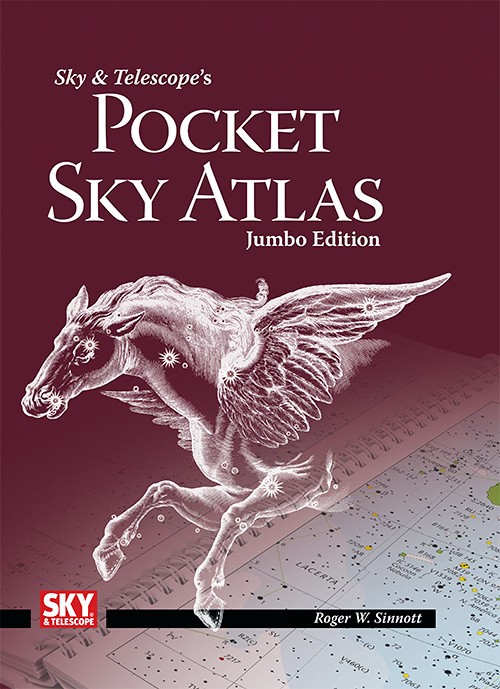
Once you get a telescope, to put it to good use you'll need a detailed, large-scale sky atlas (set of charts). The basic standard is the Pocket Sky Atlas (in either the original or Jumbo Edition), which shows stars to magnitude 7.6.
Next up is the larger and deeper Sky Atlas 2000.0, plotting stars to magnitude 8.5; nearly three times as many. The next up, once you know your way around, are the even larger Interstellarum atlas (stars to magnitude 9.5) or Uranometria 2000.0 (stars to magnitude 9.75). And read how to use sky charts with a telescope.
You'll also want a good deep-sky guidebook, such as Sky Atlas 2000.0 Companion by Strong and Sinnott, or the bigger (and illustrated) Night Sky Observer's Guide by Kepple and Sanner.
Can a computerized telescope replace charts? Not for beginners, I don't think, and not on mounts and tripods that are less than top-quality mechanically, meaning heavy and expensive. And as Terence Dickinson and Alan Dyer say in their Backyard Astronomer's Guide, "A full appreciation of the universe cannot come without developing the skills to find things in the sky and understanding how the sky works. This knowledge comes only by spending time under the stars with star maps in hand."
![]() Audio sky tour. Out under the evening sky with your
Audio sky tour. Out under the evening sky with your
earbuds in place, listen to Kelly Beatty's monthly
podcast tour of the heavens above. It's free.
"The dangers of not thinking clearly are much greater now than ever before. It's not that there's something new in our way of thinking, it's that credulous and confused thinking can be much more lethal in ways it was never before."
— Carl Sagan, 1996
"Facts are stubborn things."
— John Adams, 1770
 12
12








Comments
Rod
July 10, 2020 at 9:44 am
mary beth, New Jersey et al. Yesterday morning early I enjoyed some views of Saturn and Jupiter, Jupiter opposition on 14th. [Observed 0000-0100 EDT/0400-0500 UT.
Waning gibbous Moon rise 2318 EDT/0318 UT. I enjoyed some views of Saturn and Jupiter using 14-mm eyepiece, 1.8x Barlow lens, and the 90-mm refractor telescope. 129x views, some particularly good as altocumulus clouds passing by permitted. Jupiter many cloud bands visible, 4 Galilean moons. Saturn, Cassini division in the rings, clouds bands, some shading near north pole and the moons, Titan, and Rhea visible. Difficult viewing at times because of altocumulus clouds moving across the sky. The rising waning gibbous Moon lit up the clouds, very ethereal views. Some owls were hooting, nothing else moving around, all quiet in the fields and woods. Saturn and Jupiter retrograding in Sagittarius now. Starry Night Pro Plus 8 shows Saturn and Jupiter 6-degree 30' angular separation when I viewed.]
if weather permits for me here, early tomorrow near 0430-0500 EDT, I may view comet NEOWISE and also Venus, about 1-degree from Aldebaran in the same field of view. Using a lower power, wider field of view in the telescope may be fun 🙂 31x with 1.5-degree true field of view should work.
You must be logged in to post a comment.
mary beth
July 10, 2020 at 1:28 pm
Sounds like a very enjoyable night. Certainly help you have clear skies or, viewing! Looking forward to that report.
You must be logged in to post a comment.
New Jersey Eclipse Fan
July 10, 2020 at 5:36 pm
Your reports are great reading. And your photos (and drawing!) on the other (comet) stream were magnificent! They're tiding me over until next week when I can more conveniently search the evening skies for my own naked-eye views. You're probably aware that they nicknamed today "Fay Day" due to the Tropical Storm, which is still wreaking havoc outside my window. The next time we're supposed to have more than one day of clear skies here in Central Jersey is Tuesday and Wednesday, so I'm keeping my fingers crossed. BTW I was a big fan of the late Jack Horkheimer of the Miami Space Transit Planetarium and religiously watched his 5-minute spots on the local PBS channel, which always ran right before the station would sign off for the night. It was usually around 1:00AM, but sometimes the programming would end either early or late, so I would record it on my old VCR from 12:30 to 1:30 just to make sure I caught it, which I usually did.
You must be logged in to post a comment.
Rod
July 11, 2020 at 9:28 am
FYI, Bob King of S&T staff did the comet photos and drawing. I just view and no photos using 10x50 binoculars, 90-mm refractor telescope on altitude-azimuth tripod and Orion SkyQuest XT10i, dob mount. The Tropical Storm that passed New Jersey Eclipse Fan, also clouded up my skies too here in MD along the Patuxent River Valley farms, closer to the Chesapeake Bay area. Earlier in the week we had nearly 4 inches of rain from T-storms. Much grass cutting and weed whacking for me 🙂 Tonight where I am at, mostly clear skies and mostly sunny for tomorrow. I shall wait and see. This morning near 0300 EDT, I could just barely see the Moon because of the cloud coverage 🙂
You must be logged in to post a comment.
New Jersey Eclipse Fan
July 11, 2020 at 9:52 pm
Well I guess that makes me a New Jersey Bob & Rod & Eclipse Fan.
You must be logged in to post a comment.
Rod
July 12, 2020 at 6:29 am
mary beth, New Jersey Eclipse Fan, some great views of comet NEOWISE this morning 0415 to 0515 EDT. Clear skies and cooler temperature. I was out in a large horse pasture, I could easily see the comet with tail, unaided eyes in Auriga. About as bright as Elnath mv +1.62, Menkalinan mv +1.87 stars. It was an excellent view using my 90-mm refractor at 40x. Also Venus and Aldebaran too in the same FOV. Great morning fun 🙂 A note is posted in Bob King's report.
You must be logged in to post a comment.
mary beth
July 13, 2020 at 12:03 am
How is the weather looking for tomorrow night’s opposition? I guess you sent out an invitation to all the horses and foxes and owls for the big stargazing party!!
You must be logged in to post a comment.
Rod
July 13, 2020 at 7:31 am
mary beth, Jupiter opposition on 14th, weather for me tomorrow night, looks very good. Mostly clear skies, temps in mid-60s and sunny Wednesday - that is good for here in July. I plan to setup both telescopes and view Jupiter and Saturn. I will be cutting my east pasture today doing some prep work 🙂 Will keep folks posted---Rod
You must be logged in to post a comment.
Rod
July 15, 2020 at 12:59 am
mary beth, New Jersey Eclipse Fan. I am back in now after enjoying the Jupiter opposition. I used my 90-mm refractor telescope at 179x, and 10-inch at 34x with wide field view 1.8-degree using a 2-inch eyepiece. Jupiter, the Galilean moons, cloud bands, and many stars in Sagittarius visible around Jupiter - would make a great photo. The Great Red Spot very visible at 179x, the GRS cross the central meridian 2326 EDT. Saturn was a good view too and using the 10-inch at 34x, 4 moons visible with various stars around the planet, rings and moons. I was out from 2215-2345 EDT. I had to go in because the dew formed, my feet were soaking wet, and my telescopes were wet and eyepieces. I could see some of the Milky Way running from Cygnus through Sagittarius unaided eyes too. Fun time at Jupiter opposition 🙂
You must be logged in to post a comment.
mary beth
July 16, 2020 at 8:17 pm
Sounds like the weather cooperated! Glad to hear your viewing was a success! You saw a whole lot without having to change directions! Ready for Saturn next week?
You must be logged in to post a comment.
akdolphin8
July 17, 2020 at 12:31 am
Last night, around 10:45pm, there was a very bright light moving at a pretty good pace from the east to the west (left side of Big Dipper). I was in the backyard stargazing, wondering about NEOWISE, and noticed it traveling fairly quick. I hollered at my husband to get the kids outside. Was this the comet, or something else? It went straight overhead and maybe took maybe 3-4 minutes to span across the sky from one end of our yard to the opposite end.
You must be logged in to post a comment.
mary beth
July 17, 2020 at 12:30 pm
I am no expert but it sounds to me like you saw a satellite or the ISS. There’s a website for the international space station with all of the flyovers. The comet would have stood still. There’s also a chance it might have been the Hubble telescope. What city do you live?
https://spotthestation.nasa.gov/sightings/index.cfm
https://www.heavens-above.com/PassSummary.aspx?satid=20580
The second one called heavens above is the one for the Hubble telescope it’s a little bit hard to navigate, it’s best to sign in and then save your location.
You must be logged in to post a comment.
You must be logged in to post a comment.